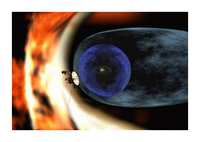Spotlight
Missions Return More than Intended
Written by: developer
 One of the extraordinary characteristics of space exploration is that the missions often return far more than they were originally designed to do. This is evident in the broad range of space developments that have been adapted to improve life on Earth. And, it is certainly evident in the accomplishments of four different NASA missions that have broken endurance records and are still sending fresh discoveries back to Earth long after their planned lifespans should have expired.
One of the extraordinary characteristics of space exploration is that the missions often return far more than they were originally designed to do. This is evident in the broad range of space developments that have been adapted to improve life on Earth. And, it is certainly evident in the accomplishments of four different NASA missions that have broken endurance records and are still sending fresh discoveries back to Earth long after their planned lifespans should have expired.
An article by David Perlman in the San Francisco Chronicle last month chronicled the Spirit and Opportunity Mars rovers originally assigned to work on the Red Planet for three months and two Voyagers that are in the 33rd year of their five-year mission.,
Now in their sixth year, Spirit and Opportunity have set the longevity record for broadcasting to Earth from a distant planet. The two Voyagers have passed the planets they were sent to study – Jupiter, Saturn, Neptune and Uranus – and now sending signals from billions of miles beyond the region of minor planets called the Kuiper Belt. Voyager 1 is about 10.5 billion miles away, speeding in the direction of the constellation Ophiuchus in the northern sky; Voyager 2 is 8.5 billion miles out, heading in the direction of the southern constellation Telescopium. Both are exploring the heliosphere, where the sun’s influence wanes and winds of subatomic particles blow from the explosions of far-off stars called supernovas.
To read the entire story, click here.
To find our more about space discoveries that improve life on Earth, visit the Space Foundation’s Space Certification website.
Pictured: Rendering of NASA’s Voyager 2 as it studies the heliosphere, a magnetic “bubble” around the solar system; coutesy of NASA/JPL-Caltech
This article is part of Space Watch: August 2010 (Volume: 9, Issue: 8).


